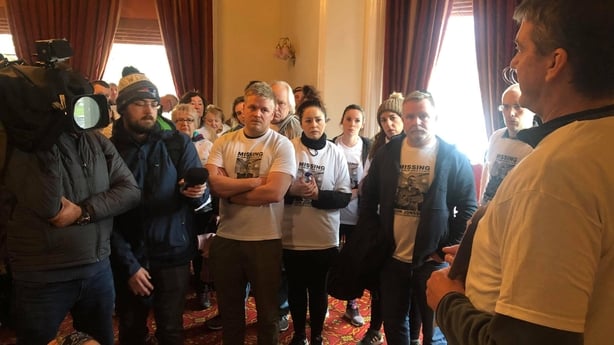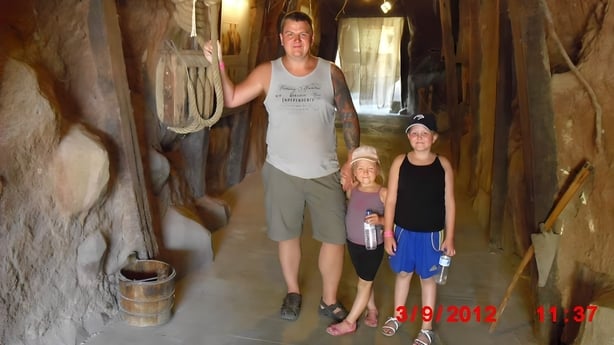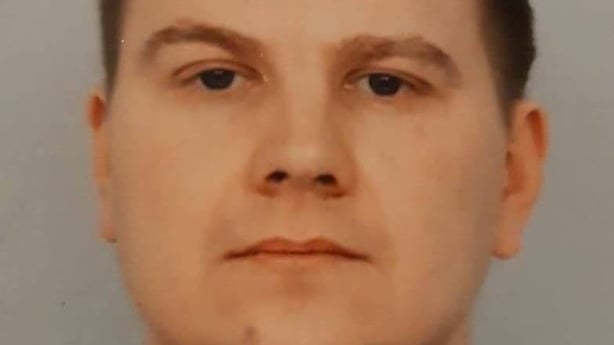There are four possible explanations for what happened to missing Icelandic poker player Jón Jónsson.
He had an accident and his remains remain undiscovered, he died by suicide, or perhaps he wanted to leave the stresses of his life behind and make a fresh start.
There is also the possibility that someone killed him and hid his body.
For those new to this story, Mr Jónsson, 41, left the Bonnington Hotel on the Swords Road, Co Dublin, on 9 February 2019. CCTV footage showed him passing the entrance to Highfield Hospital, heading towards Collins Avenue junction.
Six years later, there is no further information about his whereabouts.
RTÉ and RÚV, the public service broadcaster in Iceland, in conjunction with the Jónsson family, have created a six-part podcast series to answer the question of what really happened to Mr Jónsson and hopefully bring him home.
In the third instalment of this series, a clue that has never been made public will prove that someone out there knows something as Jón's family raise questions about the conduct of an Garda Síochána in the early days of this investigation…
To learn more keep reading or just cut to the chase and start streaming all episodes of Where is Jón? now.
Breaking news
There is no correct or easy way to tell someone that somebody is missing. When Mr Jónsson had been missing for 48 hours, his siblings decided to tell his mother, Hanna Björk Þrastardóttir.
Ms Þrastardóttir said she knew instantly that her son was no longer alive, she ended up having a "nervous breakdown" and entered a psychiatric ward.
"You can't describe it, and you need help. It was not like, I was not screaming, it was not like that, I'm not dead, but I was just like, I collapsed. The worst thing is not to know. It's difficult to deal with that."
The worst part is not knowing, she said.
Now, it was time for Nina, Mr Jónsson’s ex-wife to tell their two children.
Júlía Sif Jónsdóttir was 15 years old when her father went missing. Her younger sister Helena Rán Jónsdóttir was 11.
Both girls spoke to the podcast about the day they learned of their father’s disappearance. It is an interview no child should ever have to give and one of the most heartbreaking things you will ever hear, without question.
"I don't know, it was kind of like shock, because it didn't make sense. Because I had just sent him, like, a message, like, two days before, asking about when he would come home. - Júlía Sif Jónsdóttir

48 Hours
On 11 February, the gardaí issued the first missing persons alert for Mr Jónsson.
He had already been missing for 48 hours, arguably the crucial time period in any missing persons investigation. A fact most people who merely watch television will know.
At this juncture, gardaí contacted Icelandic police through Interpol.
Karl Steinar Valsson, Chief Superintendent, and Head of International Police Cooperation, dealt with the Irish authorities on the case.
He told the podcast that if the incident occurred on Icelandic soil things would have been handled very differently, mostly because things in Iceland are far less bureaucratic.
"We can make quite a big decision very quickly… even though Ireland is small, it's a more bureaucratic… They are not as quick."
He explained that after the first 48 to 72 hours of the investigation passes, investigators lose the option of using sniffer dogs, memories deteriorate, and from a practical perspective, people can travel a great distance in 72 hours.
After four days, the Jónsson family started to land in Dublin, and with no search operation in place from the authorities, they decided to take matters into their own hands.
Press play above to discover how one family with a little political pressure, some help from Iceland’s search and rescue services (yes, Iceland NOT Ireland), and a self-made media campaign managed to radically turn this investigation around.
In the words of Mr Jónsson’s sister Þórunn Jónsdottir: "When we got there, we saw that the police (Gardaí) wasn't really taking this seriously. So we kind of had to become detectives and search and rescue organizers and, talking to the media while we were, going through the shock.
"So I think that kind of kicked in and just took over and I was just in survival mode, trying to make everything happen, in a country, in a city that we had never been to before, where we don't know anyone."
Let that quote sink in…
My feeling as a policeman, there are things there that should have raised more suspicions because it was a little bit strange - Karl Steinar Valsson, Chief Superintendent, Head of International Police Cooperation

Ten Days Later
In the early days of the investigation, the gardaí felt there was nothing to suspect foul play, despite the Jónsson family telling them Jón’s disappearance was completely out of character.
However, once Mr Jónsson did not appear at Dublin airport for his return flight on 18 February, the attitude of the Irish authorities drastically changed, according to Mr Jónsson’s partner Kristjana Guðjónsdóttir.
For one thing, they finally asked her for a formal statement, however, it still was not enough to get them to launch an official search.
Mr Jónsson had already been missing for nearly ten days, over 98% of people who go missing are found within this time frame. So, why was there still no official search operation organised by Irish law enforcement?
The family feel potential clues were lost during this time because CCTV footage from bars, shops, and homes would have been cleared, and so too would most dash cam footage.
"So I think like the initial days, like the first days after is where they messed up the most," said Mr Jónsson’s sister, Þórunn Jónsdottir.
On 25 February 2019, the gardaí launched a full media campaign into the case. During this appeal, it was revealed that Mr Jónsson was carrying his bank cards when he went missing.
However, those cards have never been used since he disappeared.
The family appeared on every major Irish television show, from the Late Late Show, the biggest chat show in the country, to the crime tip show Crime Call, in the hopes of spreading the word of Mr Jónsson’s disappearance.
We saw a reaction, oh, this is not normal. And so they have just profiled him like he is just a gambler, and he is just a party boy, and he is just an irresponsible man who's gone off the grid. - Kristjana Guðjónsdóttir, partner

The Money Question
What has never fully been established was how much cash Mr Jónsson had left when he went missing.
Well, the family gave the podcast access to Mr Jónsson’s Google Drive to access the spreadsheets he made in advance of his trip. They also gave the producers the timeline the gardaí constructed of Mr Jónsson’s last movements in the Bonnington Hotel.
When you put this information together, things get a little clearer…
Mr Jónsson treasurer of the poker tournament in Iceland gave players admittance to the Dublin Poker Festival, which meant he was carrying around €2,500 for buy-in fees for other players.
On top of this, he had about €3,000 of his and Ms Guðjónsdóttir’s money, which meant when he touched down in Dublin, he had about €6,000 euros in cash.
Now, the CCTV timeline from the gardaí indicated that the morning he arrived, he gave the hotel reception desk an envelope, likely with cash, for the other players who had not yet arrived.
But a little after 9pm, after a difficult day of poker, he retrieved that envelope…and continued playing poker for cash with other players.
To find out how that went and solve this money mystery, start streaming.
We had the budget, we had in our accounts enough to cover the players and have extra for us. So, I think the money wasn't ever an issue, but people want to focus on. - Kristjana Guðjónsdóttir, partner
Missing Link
There is one key piece of evidence in this case that has never been released to the public. A clue that proves that somebody, somewhere, knows something about the disappearance of Jón Jónsson.
According to CCTV footage released by An Garda Síochána, Mr Jónsson was not distressed when he exited the Bonnington Hotel.
He walked past McGettigan's pub and headed towards the Swords road. He then walked off-camera, as he reached the main road and turned right.
Mr Jónsson is then seen on the Swords Road, passing Highfield Hospital.
Now, if you have been following this story, you might be screaming - WE ALREADY KNOW THIS INFORMATION.
But what happened next? Additional CCTV footage was retrieved from a bus that drove down the main Swords road the morning Mr Jónsson vanished.
This data, combined with other CCTV footage, gave Mr Jónsson a three-minute window to disappear.
Because there were no other roads he could have taken, gardaí told Mr Jónsson’s family the most likely explanation was that he got into a vehicle and was driven away from the scene.
This information was never made public, despite being the "first major clue" in Mr Jónsson’s disappearance, the podcast producers said.
It’s unclear why, but this piece of information has never been made public before now, and it’s the first major clue in Jón’s disappearance…Anna Marsibil Clausen, RÚV producer

felt there was nothing to suspect foul play'
Search Party
By the time an official search with the assistance of the Dublin Civil Defence and An Garda Síochána was launched, Mr Jónsson had been missing for 22 days.
If you’re thinking to yourself, thank goodness the authorities finally came to their senses, don’t.
This search came about in the most unorthodox of ways, and yes, it was thanks to the Jónsson family.
The Icelandic Embassy in London contacted the Dublin Civil Defence and asked for their help, usually, this is a call only made by the gardaí.
James McConnell, Dublin Civil Defence Officer, told the podcast that once this request had been made, the Jónsson family and the gardaí were contacted.
He said the search included trained searchers, and a canine unit, as well as help from the gardaí on the ground and overhead through the Garda Air Support Unit.
A command and control truck was also set up at the Bonnington Hotel as a base for family members to speak with the authorities about the search.
They searched for two days, but no new information was believed to have been ascertained.
It was a mixture of trained searchers and our dog handlers with our canine units. Also, we sent people driving out, like I said, in a spider's web from down all the streets to see if we could get any sightings…James McConnell, Dublin Civil Defence Officer
If you have any knowledge or information on the disappearance of Jón Jonsson, please contact us immediately and in confidence via documentaries@rte.ie
You can also send us anonymous information or tips via a link on our website

